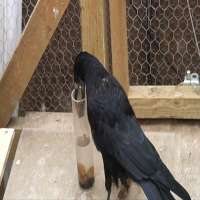Aesop's fable 'the crow and the pitcher' more fact than fiction (w/ Video)

In Aesop's fable 'The crow and the pitcher' a thirsty crow uses stones to raise the level of water in a pitcher to quench its thirst. A new study published online today (06 August) in the journal Current Biology demonstrates that rooks, birds belonging to the corvid (or crow) family, are able to solve complex problems using tools and can easily master the same technique demonstrated in Aesop's fable.
Christopher Bird of the University of Cambridge, lead author of the paper, highlighted the importance of the findings, stating: "Corvids are remarkably intelligent, and in many ways rival the great apes in their physical intelligence and ability to solve problems. The only other animal known to complete a similar task is the orang-utan.
"This is remarkable considering their brain is so different to the great apes'. Although it has been speculated in folklore, empirical tests are needed to examine the extent of their intelligence and how they solve problems."
In the first part of the study, at which point the researchers varied the height of the water, the four rooks which were the subject of the research used stones to raise the water level to reach a worm floating on top. The clever birds proved very adept and were highly successful regardless of the starting level of the water and the number of the stones needed.
Two of the birds were successful on their first try to raise the height of the water to a level at which the worm floating on top could be reached whilst the other two birds needed a second try.
The birds were also highly accurate in their ability, adding the exact number of stones needed to raise the water level to the necessary height. Additionally, rather than attempting to reach the worm after each stone was dropped, they apparently estimated the number needed from the outset and waited until the appropriate water level was reached before dipping their beaks into the tube.
In the second experiment the rooks were presented with stones which varied in size. The rooks selected larger stones over smaller ones (although not straight away). The scientists speculate that the birds learnt rapidly that the larger stones displaced more water and they were therefore able to obtain the reward more quickly than using small stones.
In the third experiment, the rooks were observed to recognise that sawdust could not be manipulated in the same manner as water. Therefore when presented with the choice between a tube half-filled with either sawdust or water, rooks dropped the pebbles into the tube containing water and not the sawdust.
Although the study demonstrates the flexible nature of tool use in rooks, they are not believed to use tools in the wild.
"Wild tool use appears to be dependent on motivation," Bird said. "Rooks do not use tools in the wild because they do not need to, not because they can't. They have access to other food that can be acquired without using tools."
As Bird noted, that fits nicely with Aesop's maxim, demonstrated by the crow: "Necessity is the mother of invention."
More information: The paper 'Rooks Use Stones to Raise the Water Level to Reach a Floating Worm' will be published on the Current Biology website.
Source: University of Cambridge (news : web)


















